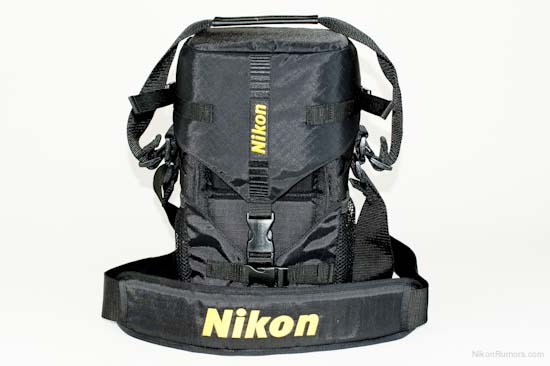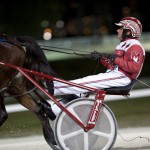
I am continuing with the tradition to have a brief hands-on for every new Nikon lens. Next in line is the Nikon AF-S 200mm f/2G ED VRII lens which I got for few days from Borrowlenses. The lens was announced on September 15th, 2010 and is an update (VRII) of the previous version.
Size, controls and ergonomics
This lens is massive – it has almost the same length as the 70-200 f/2.8 VRII but twice the diameter and weight:
Nikon actually recommends not to pick up/hold the camera body itself when this lens is attached because you can damage the mount. You have to hold the lens and the camera with both hands. You will get a better balance if you use this lens with a D3/s/x or D700 with an external battery pack.
The lens comes with a slip-on lens hood (HK-31):
The Nikkor 200mm f/2G will probably not fit in your regular photo gear bag, which is why Nikon includes a very solid built bag (CL-L1) with the lens:
You also get a front cap (LC-52), rear lens cap (LF-4), 52mm screw-on NC filter and a lens shoulder strap.
The Nikon AF-S 200mm f/2G ED VRII lens has some extra controls that you don’t see on a regular lens:
The switches from top to bottom are: Auto/Manual focus selection, range of focus selection, VR selection, AF memory recall lock (ON and LOCK options) and memory recall sound on/off switch. The VR on/of switch is actually a ring and can be easily accessed without having to look for the specific button on the side.
There is also a memory recall button, four focus operation buttons (located ion the front of the lens) that are used in conjunction with the memory recall function:
Depth-of-field indicator:
The lens is difficult to hold because of its width, weight and close proximity of the focus ring and the four focus operation buttons – for me the best way to hold it was by the tripod collar ring.
Light falloff (vignetting)
The light falloff is minimal when the lens is wide open and is almost completely gone at f/4:
Test charts
This is why this lens costs $6000: from aperture f/2 to f/8 it is hard to see any difference in the test charts… this thing is sharp (update: I removed the f/16 and f/22 tests since there was visible motion blur because the images were taken at a lower speed, unfortunately I returned the lens and cannot redo the test):
Compared with Nikkor 70-200mm f/2.8G ED VR II
Most of you probably already own the Nikkor 70-200mm f/2.8G lens and are wondering if the extra aperture stop is worth the $4000 price difference. Here is a quick comparison of both lenses at 200mm. The Nikkor 200mm f/2 VRII is definitely sharper across the board and also provides memory recall – pay attention to the small font numbers on the test chart:
f/2.8
f/4
f/5.6
The results for the rest of the apertures are similar. Of course there is a margin of error in those test chart comparisons.
The full resolution test images are available on flickr. In the slide shows below you can also get a feeling of the bokeh of both lenses at different aperture levels (first slideshow is the 200mm f/2, the 70-200mm f/2.8 is second):
Samples
To test this lens, I needed low light, something fast and big to fill the frame – horse racing seems to fit all that. All pictures were taken with a Nikon D700. The photos were not post-processed in any way. I wanted to show the images the way they came out of the camera. I used Lightroom 3 to convert and resize the original NEF to JPG files. All pictures were taken handheld at f/2, ISO 1600:
Here are 100% crops from two of the above photos (click on image for the actual 100% crop):
Bokeh
The bokeh of the Nikon 200mm f/2 lens is smooth and creamy. Here are some examples from different environments:
Bokeh comparison of the 200mm f/2 lens (left) with the Nikon 85mm f/1.4G (right):
More samples with higher resolution are available on flickr.
And finally, three photos that were slightly post-processed in Lightroom (click on images for larger view):
Other Nikon AF-S 200mm f/2G ED VRII lens info
- Main features:
- Nano coating (N)
- Manual/Autofocus mode switch (M/A)
- Internal focus (IF)
- Integrated Nikon Silent Wave Motor (SWM)
- Nikon Super Integrated Coating (SIC)
- Distance window
- Rounded 9-blade diaphragm
- 52mm filter size
- 13 elements in 9 groups
- 3 ED glass and 1 Super ED glass elements
- Compatible with all Nikon teleconverters
- Minimum aperture is f/22
- Angle of view in full frame: 12°20’
- Reproduction Ratio: 0.12x
- Minimum focusing distance: 1.9 m/6.2 ft
- Product number 2188
- Weight: 2,930 g|103.4 oz
- Dimensions: 124 x 203.5 mm|4.9 x 8.0 in
- Rotating tripod collar (360°)
- The price of the new version is $5,999.95 vs. $4,579.00 for the old one or you can just rent one from BorrowLenses.
- MTF chart:
- Lens construction:
Conclusion
The Nikkor AF-S 200mm f/2G ED VRII is probably the sharpest Nikon lens. Big, heavy and expensive but worth every penny in my opinion.
I would like to thank BorrowLenses for the lens rental.





















































